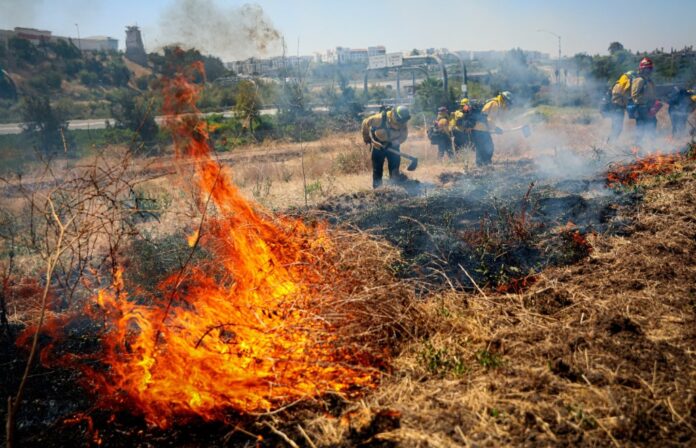The hot weather that moved into San Diego County shortly before July 4 will last another week, posing potential health threats and raising the risk of wildfire in a region where highly combustible vegetation has grown thicker as a result of last winter’s rains, the National Weather Service said.
The unusually long heat wave is stifling much of the western U.S., and California is being hit hard. Firefighters struggled Saturday to knock down a wildfire that has burned more than 12,000 acres in the Los Padres National Forest in Santa Barbara County. Crews made better progress against a 908-acre blaze in Mariposa, near Yosemite National Park.
Temperatures eased a bit in Palm Springs over the weekend, where the city hit an all-time record high of 124 degrees on Friday. But Saturday’s daytime high still reached a blistering 114. Phoenix braced for the possibility that temperatures could be in the 115 to 120 range through late next week.
Most San Diego County cities didn’t reach those levels Saturday. But it was plenty hot. The weather service listed these highs: Ocotillo Wells, 115, Borrego Springs, 114, Julian, 102, Campo, 101, Lake Cuyamaca, 99, Ramona, 98, Valley Center, 97, Escondido, 97, Poway, 96, Alpine, 96, Mount Laguna, 93, Fallbrook, 92, Gillespie Field, 91, El Cajon, 91, San Marcos, 89, Vista, 87, Rancho Bernardo, 87, Rancho San Diego, 87, Miramar MCAS, 84, Santee, 83, Montgomery Field, 81, Encinitas, 81, Lemon Grove, 78, San Diego International Airport, 76, National City, 75, Chula Vista, 75.
The heat drove hordes of people to the coast, where a sea breeze fluttered for much of the day. The streets leading to La Jolla Shores resembled a clogged artery. Traffic slowed on Coast Highway as sun-worshippers tried to angle their way into Torrey Pines State Beach.
The county didn’t have to cope with new wildfires, but firefighters were on alert. The region has recently experienced a series of comparatively small brush fires, including one in Del Mar that forced 2,500 people to evacuate their homes.
The heat is being caused by a high pressure system that will weaken a bit on Monday, then quickly rebuild. Beach cities will continue to be fairly cool due to sporadic onshore winds. But areas generally east of Interstate 15 will be in the 80s and 90s until late next week, forecasters said.
The weather service is using a sliding scale to describe the potential danger the heat presents to humans, animals and structures, such as housing. The excessive heat scale goes from zero to limited to elevated to significant to extreme. People are at an increased danger for heat exhaustion, starting with limited.
San Diego’s deserts will be under an extreme heat and fire weather advisory through at least Thursday. The county’s valleys — which include Julian, Mount Laguna and Palomar Mountain — with go back and forth between moderate and major heath and fire danger. And valley communities — including Escondido, Ramona and Alpine — will experience minor to moderate heat and fire weather conditions.
The advisories mean that most of San Diego County’s roughly 3.3 million people will have to cope with prolonged heat exposure.
Things could be worse.
The summer monsoon is usually underway by now. But it has yet to begin and isn’t likely to appear until at least next Saturday, forecasters said. The monsoon often produces lightning, a phenomenon that has triggered many wildfires over the years in San Diego County’s backcountry. The region is covered with chaparral, a particularly flammable type of vegetation.






